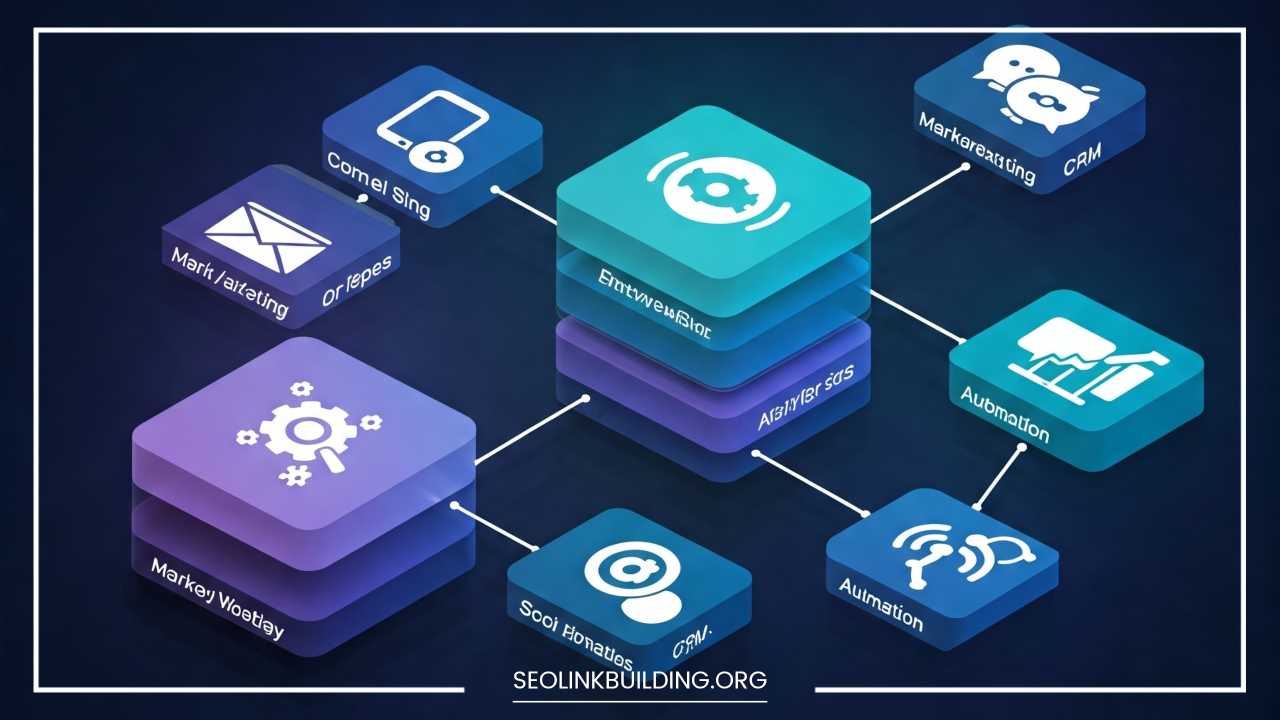Marketing Tech Stack: The Essential Guide

Marketing Tech Stack
The Indispensable Engine: Mastering Your Marketing Tech Stack in the Digital Age
In today’s hyper-connected and data-driven world, marketing has shifted from relying on intuition and broad strategies to becoming a highly precise and scientific endeavor.
At the core of this transformation lies the marketing technology stack, a carefully curated collection of software and tools that empowers modern marketers to plan, execute, analyze, and optimize campaigns across a multitude of channels.
More than just a collection of individual applications, a well-integrated marketing tech stack serves as the indispensable engine driving business growth, fostering lasting customer relationships, and ultimately helping organizations achieve their strategic objectives.
This article delves deeply into the dynamic world of marketing tech stacks, exploring their definition, significance, essential components, the strategic process of building one, the challenges that arise, and the exciting future that awaits.
Understanding and mastering your marketing tech stack is no longer optional; it is a foundational necessity for organizations aiming for success in the fast-paced, competitive digital arena.
What Exactly is a Marketing Tech Stack?
At its core, a marketing tech stack is an ecosystem of technology solutions that marketing teams use to manage, automate, and optimize their marketing efforts.
Think of it as a digital toolkit, where each tool serves a specific purpose, contributing to the overall marketing process.
These tools range from foundational platforms like Customer Relationship Management (CRM) systems to specialized applications for email marketing, social media management, content creation, analytics, and much more.
The concept of a “stack” emphasizes the interconnectedness and integration of these tools. Ideally, the components of a marketing tech stack should seamlessly work together, sharing data and insights to provide a unified view of customer behavior and campaign performance.
This integration allows marketers to gain a deeper understanding of their audience, personalize messaging, automate repetitive tasks, and ultimately deliver more effective and impactful marketing experiences.
Marketing tech stacks are not one-size-fits-all solutions. The specific tools and platforms included will vary significantly depending on the size of the organization, its industry, target audience, marketing goals, and budget.
A small startup might rely on a handful of essential tools, while a large enterprise could have a complex stack comprising dozens of specialized applications.
Regardless of its size or complexity, the principle remains the same: to leverage technology to enhance marketing effectiveness, drive innovation, and maximize efficiency.
The Paramount Importance of a Robust Marketing Tech Stack
In an era where consumers are overwhelmed with marketing messages from countless sources, breaking through the noise and building meaningful connections requires a strategic, technology-driven approach.
A well-constructed marketing tech stack offers numerous benefits that are essential for success in today’s competitive and fast-evolving digital landscape:
Enhanced Efficiency and Automation:
Marketing technology automates routine and repetitive tasks, allowing marketers to focus on higher-level strategy and creativity.
From automated email campaigns and social media scheduling to lead nurturing workflows and personalized content delivery, automation streamlines processes, reduces manual errors, and boosts overall productivity.
Tasks that once took hours or days can now be completed in minutes, allowing teams to work smarter, not harder.
Deeper Customer Understanding and Personalization:
A well-integrated tech stack gives marketers the ability to collect, analyze, and synthesize vast amounts of customer data from a variety of touchpoints.
This data provides rich insights into customer preferences, behaviors, and needs, enabling marketers to craft highly personalized experiences, offers, and messaging that resonate with individuals.
Personalization leads to higher engagement, improved customer satisfaction, and ultimately greater conversion rates.
Data-Driven Decision Making:
Marketing technology offers robust analytics and reporting capabilities that allow marketers to track campaign performance, measure ROI, and make informed decisions.
By leveraging data, organizations can remove the guesswork from their marketing strategies, ensuring that campaigns are aligned with business objectives and are delivering measurable results.
Marketers can identify successful tactics, uncover areas for improvement, and continuously refine their approach to optimize outcomes.
Improved Customer Experience:
By leveraging the power of technology, marketers can offer more seamless, relevant, and personalized experiences across various touchpoints.
Whether interacting with a brand on social media, through email, or on a website, technology enables marketers to deliver tailored content that addresses the unique needs of each customer, enhancing their overall experience.
A superior customer experience encourages loyalty, drives repeat business, and turns customers into vocal advocates for the brand.
Scalability and Growth Enablement:
As organizations grow, so do their marketing needs. A robust tech stack provides the scalability necessary to handle increased data volumes, more sophisticated campaigns, and expanded customer bases.
This scalability ensures that businesses can continue to reach larger audiences, deliver tailored marketing experiences at scale, and manage increasingly complex marketing initiatives as they evolve.
Enhanced Collaboration and Communication:
Many marketing technology platforms offer built-in tools for collaboration and communication among team members and across departments.
These features help ensure alignment within marketing teams and across other functions like sales, product, and customer service.
When everyone is on the same page and has access to shared data, businesses can work together more efficiently toward common objectives.
Competitive Advantage:
In today’s competitive landscape, businesses that effectively leverage marketing technology hold a significant edge over those that do not.
A sophisticated tech stack empowers marketers to execute innovative, data-driven campaigns, reach target audiences more effectively, and ultimately create more impactful experiences.
Organizations that invest in marketing technology are well-positioned to stay ahead of the curve and drive greater business value.
Navigating the Landscape: Key Components of a Marketing Tech Stack
The marketing technology landscape is vast, continuously evolving, and filled with a variety of tools and platforms that address different marketing needs.
While the exact components of a marketing tech stack will vary across organizations, certain categories of tools are essential for most:
Customer Relationship Management (CRM):
A CRM system serves as the backbone of a marketing tech stack, consolidating all customer-related data, including contact information, interactions, and purchase history.
CRMs like Salesforce, HubSpot CRM, and Zoho CRM help marketers track and manage customer relationships, improve lead nurturing, and gain a comprehensive view of the customer journey.
Marketing Automation Platforms:
Marketing automation platforms streamline workflows by automating processes like lead nurturing, email marketing, social media management, and campaign tracking.
Popular platforms such as Marketo, Pardot, HubSpot Marketing Hub, and Eloqua provide marketers with the tools to execute highly personalized campaigns at scale.
Email Marketing Software:
While often integrated within marketing automation platforms, standalone email marketing tools like Mailchimp, Constant Contact, and SendGrid offer specialized features for creating, sending, and analyzing email campaigns.
These tools allow marketers to segment audiences, personalize content, automate email sequences, and track performance metrics like open and click-through rates.
Content Management System (CMS):
A robust CMS like WordPress, Drupal, or Contentful enables marketers to create, manage, and publish website content, blog posts, landing pages, and other digital assets.
A flexible CMS is essential for maintaining a dynamic online presence that drives customer engagement and supports lead generation efforts.
Search Engine Optimization (SEO) Tools:
To boost organic visibility, SEO tools like SEMrush, Ahrefs, and Moz help marketers with keyword research, website performance analysis, ranking tracking, and content optimization.
These tools ensure that websites rank well in search engine results, driving traffic and increasing the potential for conversions.
Social Media Management Tools:
Platforms like Hootsuite, Sprout Social, and Buffer make it easy to manage social media accounts, schedule posts, monitor engagement, and analyze performance.
These tools help marketers execute social media campaigns that increase brand visibility and customer interaction.
Analytics and Reporting Tools:
Google Analytics, Adobe Analytics, and Mixpanel are essential for tracking website traffic, user behavior, and campaign performance.
By providing insights into key metrics, these tools help marketers identify trends, optimize strategies, and demonstrate ROI.
Advertising Platforms:
Paid advertising platforms such as Google Ads, Facebook Ads Manager, and LinkedIn Ads offer tools for targeting, creating, and managing online ad campaigns.
These platforms allow marketers to engage with highly specific audiences and achieve precise marketing objectives through targeted ad spend.
Customer Data Platforms (CDP):
CDPs like Segment, Tealium, and mParticle enable organizations to unify customer data from various sources into a single, comprehensive view.
This data consolidation allows marketers to create more personalized, relevant, and consistent customer experiences across all channels.
Personalization and Recommendation Engines:
Tools like Optimizely, Dynamic Yield, and Monetate leverage data and algorithms to deliver personalized content and product recommendations based on customer behavior.
These tools help create tailored shopping experiences that increase engagement and conversion rates.
Video Marketing Platforms:
As video continues to dominate content consumption, tools like Wistia, Vimeo, and Brightcove provide marketers with solutions for hosting, managing, and analyzing video content. These platforms enable the creation of engaging video campaigns that connect with customers on a deeper level.
Collaboration and Project Management Tools:
Marketing teams often rely on tools like Asana, Trello, and Slack to manage projects, communicate seamlessly, and stay organized. These tools ensure that teams stay aligned, deadlines are met, and goals are achieved.
This list is by no means exhaustive, but it covers the core components that form the foundation of a successful marketing tech stack.
The Art and Science of Building Your Marketing Tech Stack
Building an effective marketing tech stack requires more than simply purchasing the latest tools. It’s about strategically selecting the right technologies that align with your goals, audience, and infrastructure. Here’s a step-by-step guide to help you create a powerful marketing engine:
- Define Your Marketing Goals and Objectives:
Start by clearly defining what you want to achieve. Is it increasing brand awareness, generating leads, driving sales, or improving customer retention? Your goals will guide your selection of tools. - Understand Your Target Audience and Their Journey:
Study your audience deeply. Identify their needs, pain points, and behaviors. Map their journey from awareness to conversion, and identify where marketing technology can play a role in enhancing engagement. - Assess Your Current Technology Infrastructure:
Evaluate your existing tools and platforms. Identify gaps, redundancies, or inefficiencies in your current tech stack, and assess what systems can be integrated or replaced. - Prioritize Needs and Budget:
Determine your most critical needs based on your marketing goals and available resources. Consider the budget for technology investments and allocate accordingly to meet your needs without overextending. - Research and Evaluate Tools:
Dive into the features and capabilities of potential tools. Read reviews, request demos, and even test out tools before committing. Make sure they integrate well with existing systems. - Start with Essentials and Scale Gradually:
Focus on essential tools first, such as a CRM and marketing automation platform, and then expand your stack as your business grows and needs evolve. - Ensure Integration Between Tools:
A successful stack is one where tools work together. Make sure all platforms are capable of seamless integration to ensure smooth data flow and consistency across systems. - Focus on Training and Adoption:
Your team should be well-trained in the tools you choose. Offer training sessions and provide ongoing support to ensure maximum adoption and value extraction from your technology stack. - Evaluate and Optimize Continuously:
The tech landscape is ever-evolving. Regularly review your marketing tech stack’s performance, look for new tools to address emerging needs, and optimize for greater efficiency.
Navigating the Challenges and Considerations
While the benefits of a well-implemented tech stack are clear, several challenges need to be considered:
- Integration Complexities: Integrating disparate tools can be complex. Consider middleware solutions if necessary.
- Data Silos: Ensure that data flows smoothly between tools to avoid silos and ensure accessibility across platforms.
- Cost: Marketing technology can be expensive. Be mindful of costs and ROI when selecting tools.
- Keeping Up with Advancements: Stay informed about the latest trends and continuously evolve your tech stack to remain competitive.
- Training and Adoption: Ensure that your team is adequately trained on all tools to maximize their impact.
The Future is Integrated and Intelligent
The future of marketing tech stacks is likely to involve increased integration and intelligence:
- AI and Machine Learning: Expect a surge in AI-driven tools that automate tasks, personalize experiences, and offer deeper insights.
- Focus on Personalization: Expect tech stacks to enable even more refined, personalized customer interactions.
- Unified Platforms: Unified platforms may become more common, reducing the need for disparate tools.
- Data Privacy: With rising concerns over privacy, expect marketing tech stacks to prioritize secure, compliant systems.
Final Thoughts: Embracing the Power of Marketing Technology
In conclusion, the marketing tech stack is no longer a luxury but a necessity in today’s competitive business environment.
By thoughtfully selecting, integrating, and leveraging the right tools, organizations can streamline operations, gain deep customer insights, personalize experiences, and drive data-driven decisions.
Building and maintaining an effective tech stack is an ongoing process, but the payoff in terms of improved performance, stronger customer relationships, and sustainable growth is immense.
As the digital landscape continues to evolve, embracing marketing technology is essential for staying competitive and thriving in the years ahead.













